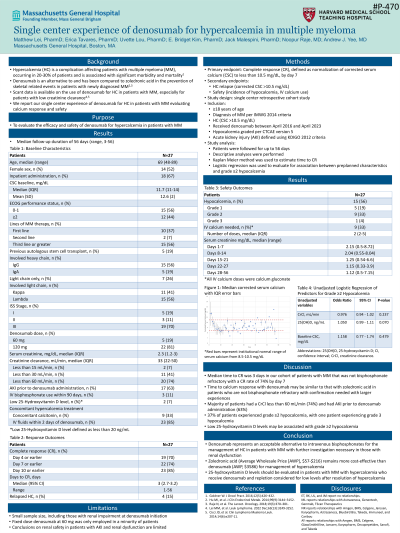QoL and Patient-Reported Outcome and Supportive Care
Poster Session 3
P-470: Single center experience of denosumab for hypercalcemia in multiple myeloma
Friday, September 29, 2023
1:15 PM - 2:15 PM EEST


Matthew Lei, PharmD (he/him/his)
Clinical Pharmacy Specialist
Massachusetts General Hospital
Boston, Massachusetts, United States
Introduction: Hypercalcemia (HC) is a frequent complication of multiple myeloma (MM) occurring in 20-30% of patients. This is often associated with renal dysfunction and both features are important myeloma defining events resulting in significant morbidity and mortality. Denosumab, a fully human monoclonal antibody that inhibits RANKL, has been evaluated in the prevention of skeletal related events in patients with newly diagnosed MM, as well as the treatment of bisphosphonate-refractory HC of malignancy (HCM). Cases of denosumab for HCM in MM patients with renal dysfunction have been described. Although denosumab and IV bisphosphonates (IVB) represent treatment options for HC in MM, there is limited data on the use of denosumab for HC in patients with MM. We describe a cohort of patients with MM with HC who received denosumab.
Methods: We retrospectively identified patients age ≥18 with a diagnosis of MM with HC (corrected serum calcium level [CSC] >10.5 mg/dL). Patients were included if they received denosumab between April 2016 and April 2023. The primary endpoint was complete response (CR), defined as normalization of CSC to less than 10.5 mg/dL. Secondary endpoints included HC relapse (CSC >10.5 mg/dL) and safety. Hypocalcemia was graded per CTCAE v5. Acute kidney injury (AKI) was defined using KGIDO criteria. Patients were followed-up for 56 days. Bivariate analyses were performed. The Kaplan Meier method was used to estimate time to CR.
Results: A total of 27 patients were included. 37% (n=10) of patients had newly diagnosed MM. 19% (n=5) of patients received a dose of 60 mg, the majority of whom had significant renal dysfunction; all other patients received a dose of 120 mg. Most patients received HC treatment as an inpatient (67% inpatient vs. 33% outpatient). A minority of patients had received IVBs in the past 90 days (15%; n=4). The median CSC was 12.2 mg/dL (interquartile range [IQR], 11.5-14.0). Baseline median serum creatinine (SCr) and creatinine clearance (CrCl) was 2.2 mg/dL (IQR, 1.2-3.0) and 30.7 mL/min (IQR, 20.8-42.2), respectively. Incidence of AKI at baseline was 63% (n=17). The CR rate by day 10 was 81%. The median time to CR was 3 days (95% CI, 2.7-3.2). Three patients did not achieve CR. HC relapse occurred in 4 (15%) patients. All grade hypocalcemia was 56% (n=15) while grade ≥2 hypocalcemia was 37%; one patient experienced grade 3 hypocalcemia. No patients in the denosumab group received an additional dose of denosumab within 14 days of initial dose.
Conclusions: We describe our experience with denosumab for the management of HC in patients with MM. The median time to CR was 3 days in our MM only population that was not bisphosphonate refractory. A high incidence of grade 2 hypocalcemia was noted. Conclusions on renal safety are limited by the small sample size. Denosumab represents an acceptable alternative to intravenous bisphosphonates for the management of HC in MM patients with further investigation necessary in those with renal dysfunction.
Methods: We retrospectively identified patients age ≥18 with a diagnosis of MM with HC (corrected serum calcium level [CSC] >10.5 mg/dL). Patients were included if they received denosumab between April 2016 and April 2023. The primary endpoint was complete response (CR), defined as normalization of CSC to less than 10.5 mg/dL. Secondary endpoints included HC relapse (CSC >10.5 mg/dL) and safety. Hypocalcemia was graded per CTCAE v5. Acute kidney injury (AKI) was defined using KGIDO criteria. Patients were followed-up for 56 days. Bivariate analyses were performed. The Kaplan Meier method was used to estimate time to CR.
Results: A total of 27 patients were included. 37% (n=10) of patients had newly diagnosed MM. 19% (n=5) of patients received a dose of 60 mg, the majority of whom had significant renal dysfunction; all other patients received a dose of 120 mg. Most patients received HC treatment as an inpatient (67% inpatient vs. 33% outpatient). A minority of patients had received IVBs in the past 90 days (15%; n=4). The median CSC was 12.2 mg/dL (interquartile range [IQR], 11.5-14.0). Baseline median serum creatinine (SCr) and creatinine clearance (CrCl) was 2.2 mg/dL (IQR, 1.2-3.0) and 30.7 mL/min (IQR, 20.8-42.2), respectively. Incidence of AKI at baseline was 63% (n=17). The CR rate by day 10 was 81%. The median time to CR was 3 days (95% CI, 2.7-3.2). Three patients did not achieve CR. HC relapse occurred in 4 (15%) patients. All grade hypocalcemia was 56% (n=15) while grade ≥2 hypocalcemia was 37%; one patient experienced grade 3 hypocalcemia. No patients in the denosumab group received an additional dose of denosumab within 14 days of initial dose.
Conclusions: We describe our experience with denosumab for the management of HC in patients with MM. The median time to CR was 3 days in our MM only population that was not bisphosphonate refractory. A high incidence of grade 2 hypocalcemia was noted. Conclusions on renal safety are limited by the small sample size. Denosumab represents an acceptable alternative to intravenous bisphosphonates for the management of HC in MM patients with further investigation necessary in those with renal dysfunction.
